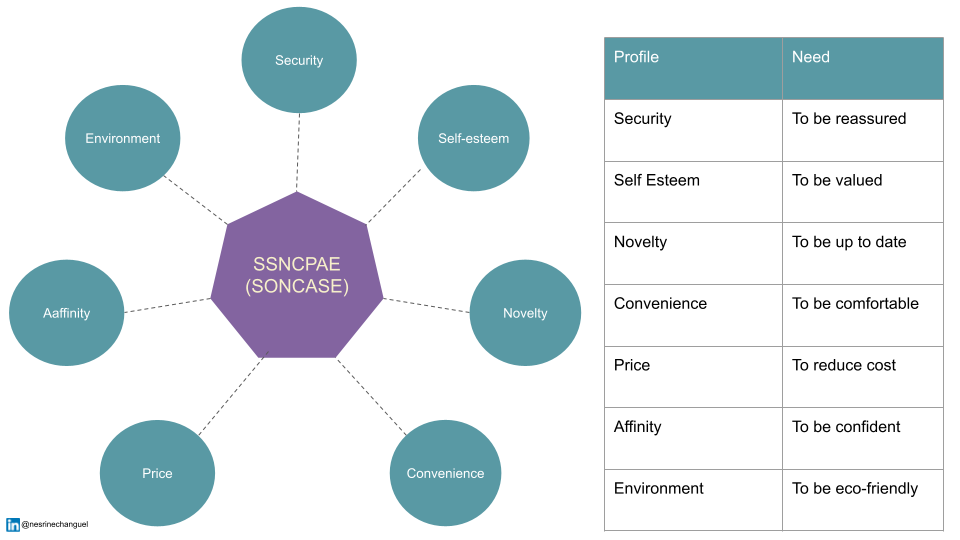In the pursuit of building products that deeply resonate with users, understanding their emotional motivators is crucial. While functional needs often take the spotlight in product development, emotional needs are what differentiate truly exceptional products from the rest. But how can teams systematically uncover these emotional drivers? One not that much approach is the SONCASE Method.
What is the SONCASE Method?
The SONCASE Method is a framework designed to identify and categorize human emotional motivators. Originally developed in France by Jean-Denis Larradet in 1993 in the field of sales psychology, this selling technique aims to identify the needs of leads, and to adapt the sales pitch in line with their main purchase incentives. The method's initials make up the acronym SONCASE: Sécurité (Security), Orgueil (Self-esteem), Nouveauté (Novelty), Confort (Convenience), Argent (Price), Sympathie (Affinity). Écologie (Ecology) was added in recent years.
The SONCASE method has since been adapted for user research, marketing, and product design, helping teams understand the deeper psychological triggers that drive engagement, loyalty, and advocacy.
The method is structured around seven core emotional needs, represented by the acronym SONCASE:
Security – Users seek reassurance, trust, and stability.
Orality – The desire for sensory pleasure and social interactions.
Novelty – The need for discovery, excitement, and new experiences.
Comfort – A preference for ease, simplicity, and convenience.
Accomplishment – The drive for personal growth, achievement, and mastery.
Social Approval – The aspiration for recognition, status, and belonging.
Ethics – Alignment with personal values, social responsibility, and integrity.
These categories serve as a guide to map out why users make certain choices, allowing product teams to craft experiences that go beyond mere functionality.
Why Use the SONCASE Method in Product Development?
1. It Reveals Deep Emotional Motivators
Traditional research methods often focus on explicit user feedback, which leans toward functional needs. However, users don’t always articulate their emotional drivers. By leveraging the SONCASE framework, teams can probe deeper into the underlying emotions influencing behavior.
2. It Helps Differentiate Products through Emotional Connection
Many successful products stand out not just because they solve a problem efficiently but because they create an emotional bond with users. The SONCASE Method helps uncover the emotional "why" behind user decisions, enabling teams to design experiences that feel personal and meaningful.
3. It Aligns with Motivational Segmentation
Rather than grouping users by demographics or usage patterns, the SONCASE framework helps categorize them based on their emotional needs. This approach aligns well with motivational segmentation, a method that categorizes users by their underlying goals and desires.
4. It Guides the Design of Delightful Features
Applying the SONCASE Method allows teams to identify not just pain points but also opportunities for delight. For instance:
If users are driven by Accomplishment, adding achievement badges or progress tracking can enhance motivation.
If Social Approval is a key driver, integrating community-building features can boost engagement.
If Security is a priority, providing clear guarantees and trust signals improves retention.
How to Apply the SONACSE Method to Your Product
Step 1: Conduct User Research with an Emotional Lens
Instead of just asking users what they want, dig deeper into their emotional states:
What fears do they have? (Security)
What experiences bring them joy? (Orality, Novelty)
What achievements make them feel proud? (Accomplishment)
What social recognition do they seek? (Social Approval)
Step 2: Map Insights to the Seven Motivators
Once qualitative insights are gathered from interviews, surveys, or behavioral data, categorize them using the SONCASE framework. This exercise will help pinpoint which emotional needs are dominant among your user base.
Step 3: Design Features That Address These Needs
Brainstorm and prioritize features that align with users' emotional motivators. Use the SONCASE framework to ensure that emotional drivers are not overlooked in favor of only functional improvements.
Step 4: Measure Emotional Impact
Just as we track product-market fit, it’s essential to measure how well a product satisfies users’ emotional needs. This can be done through qualitative feedback, sentiment analysis, and engagement metrics.
Hypothetical Case Study: Applying the SONCASE Method in a Wellness App
A wellness app looking to increase engagement and long-term retention could apply the SONCASE Method to better understand its users' emotional motivators.
If comfort is a priority for users, the app could focus on a seamless, intuitive user experience with soothing design elements and personalized recommendations. Those motivated by accomplishment might respond well to progress tracking, milestone celebrations, and gamified challenges. For users driven by social approval, integrating a community feature where they can share progress and interact with others could foster deeper engagement.
By systematically addressing these emotional motivators, the app could create an experience that feels rewarding and meaningful, encouraging users to return regularly and form long-term habits. The result would not just be increased retention but a stronger emotional connection between the product and its users.
Conclusion: Turning Emotional Insights into Competitive Advantage
In an era where differentiation is more challenging than ever, emotional connection is the new competitive edge. The SONCASE Method offers a structured way to identify and leverage users' emotional motivators, ensuring that products not only function well but also resonate on a deeper level.
By integrating this approach into your product development strategy, you can create experiences that not only meet needs but also foster loyalty, advocacy, and long-term engagement. After all, the most beloved products aren’t just used—they are felt.




